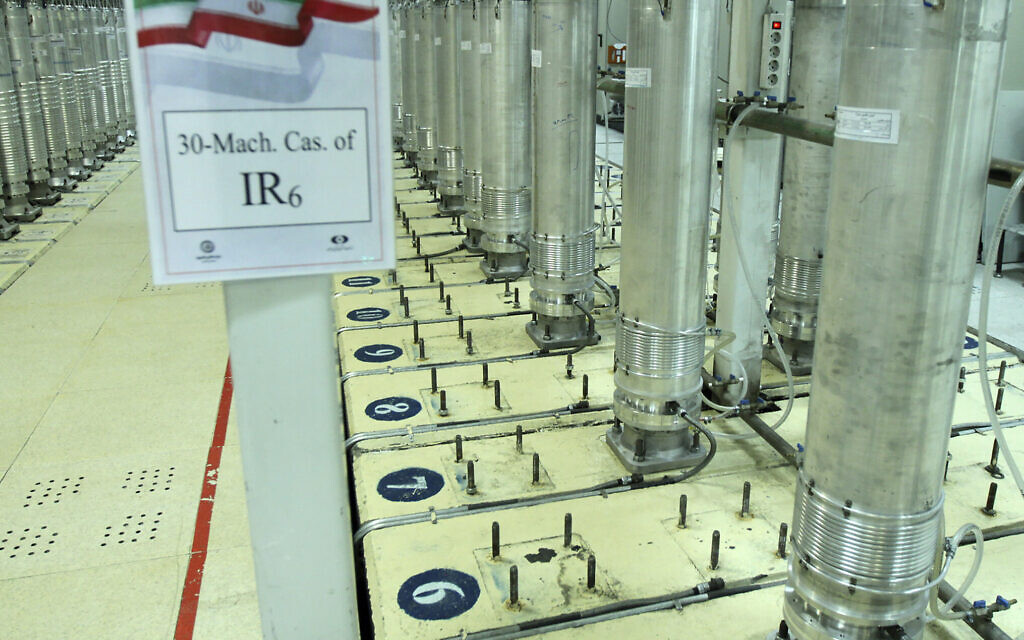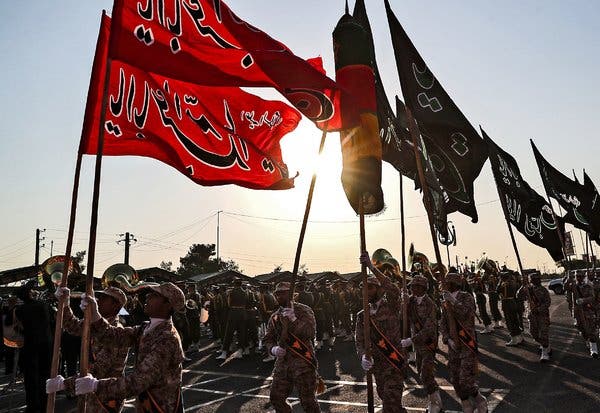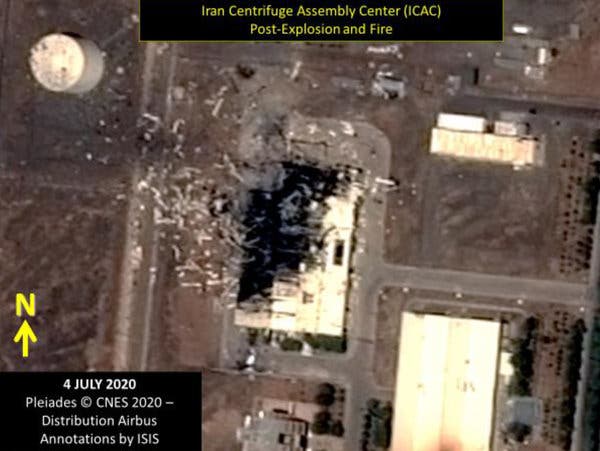Long-Planned and Bigger Than Thought: Strike on Iran’s Nuclear Program
Some officials say that a joint American-Israeli strategy is evolving — some might argue regressing — to a series of short-of-war clandestine strikes.
Members of Iran’s Islamic Revolutionary Guards Corps during a military parade in Tehran last year.Credit...Iranian Presidency, via Agence France-Presse — Getty Images



By
David E. Sanger,
Eric Schmitt and
Ronen Bergman
- July 10, 2020 | Updated 1:54 p.m. ET
As Iran’s center for advanced nuclear centrifuges lies in charred ruins
after an explosion, apparently engineered by Israel, the long-simmering conflict between the United States and Tehran appears to be escalating into a potentially dangerous phase likely to play out during the American presidential election campaign.
New satellite photographs over the stricken facility at Natanz show far more extensive damage than was clear last week
. Two intelligence officials, updated with the damage assessment for the Natanz site recently compiled by the United States and Israel, said it could take the Iranians up to two years to return their nuclear program to the place it was just before the explosion. An
authoritative public study estimates it will be a year or more until Iran’s centrifuge production capacity recovers.
Another major explosion hit the country early Friday morning, lighting up the sky in a wealthy area of Tehran. It was still unexplained — but appeared to come from the direction of a missile base. If it proves to have been another attack, it will further shake the Iranians by demonstrating, yet again, that even their best-guarded nuclear and missile facilities have been infiltrated.
Although Iran has said little of substance about the explosions, Western officials anticipate some type of retaliation, perhaps against American or allied forces in Iraq, perhaps a renewal of cyberattacks. In the past, those have been directed against American financial institutions, a major Las Vegas casino and a dam in the New York suburbs or, more recently, the water supply system in Israel,
which its government considers “critical infrastructure.”
Officials familiar with the explosion at Natanz compared its complexity to the sophisticated Stuxnet cyberattack on Iranian nuclear facilities a decade ago, which had been planned for more than a year. In the case of last week’s episode, the primary theory is that an explosive device was planted in the heavily-guarded facility, perhaps near a gas line. But some experts have also floated the possibility that a cyberattack was used to trigger the gas supply.
Some officials said that a joint American-Israeli strategy was evolving — some might argue regressing — to a series of short-of-war clandestine strikes, aimed at taking out the most prominent generals of the Islamic Revolutionary Guards Corps and setting back Iran’s nuclear facilities.
The closest the administration has come to describing its strategy of more aggressive pushback came in comments last month from Brian H. Hook, the
State Department’s special envoy for Iran. “We have seen historically,’” he concluded, “that timidity and weakness invites more Iranian aggression.”
The next move may be a confrontation over four tankers, now making their way to Venezuela, which the United States has vowed will not be allowed to deliver their cargo of Iranian oil in violation of United States sanctions.
The emerging approach is risky, analysts warn, one that over the long term may largely serve to drive Iran’s nuclear program further underground, and thus make it harder to detect.
But in the short term, American and Israeli officials are betting that Iran will limit its retaliation, as it did after an American drone in January
killed Maj. Gen. Qassim Suleimani, one of Iran’s most important commanders.
While some American officials expressed fears that the killing of General Suleimani would lead Iran to initiate a war against the United States, the C.I.A. director, Gina Haspel, reassured them that the Iranians would settle on limited missile attacks against American targets in Iraq — which so far has turned out to be correct. Iran’s limited response could be an incentive for further operations against it.
In addition, some American and Israeli officials, and international security analysts, say that Iran may believe that President Trump will lose the November election and that his presumptive Democratic rival, Joseph R. Biden Jr., will want to resurrect some form of
the negotiated settlement that the Obama administration reached with Tehran five years ago next week.
A satellite image of the destruction at Natanz, as seen on July 4.Credit...via Institute for Science and International Security
“Today, if you are Iran, why compromise with an administration which may only have a few months left?’’ asked Karim Sadjadpour, a senior fellow at the Carnegie Endowment for International Peace.
But in the short term, he noted, the new offensive has put Iran under “extreme internal and external pressure,” as its oil exports continue to be squeezed and its efforts to revive the nuclear program, retribution for Mr. Trump’s
decision in May 2018 to abandon the 2015 accord, falters amid sabotage.
“Think about it,’’ he said. “Geographically, Iran is greater in size than Germany, France and the United Kingdom combined. But they have never managed to pursue a clandestine nuclear program without getting caught, or protected their program from sabotage. Are there defectors or traitors inside the system?”
When the Mossad raided a warehouse in Tehran in January 2018, and emerged with tens of thousands of pages of nuclear-weapons planning documents dating back nearly two decades, it clearly had the help of insiders. The killing of General Suleimani, the mastermind of Iran’s actions in Iraq and attacks on Americans — which was also based on intelligence, much of it given by live agents — was perhaps Mr. Trump’s most aggressive military move as president.
The Natanz explosion occurred inside the Iran Centrifuge Assembly Center, where the country was building its most advanced machines, designed to produce far more nuclear fuel, far faster, than the old machines used until Iran dismantled most of its facilities in the 2015 accord.
While research on those machines was permitted under the agreement, they could not be deployed for years — and Iran’s crash effort to mass produce them was an ambitious effort to show that it could respond to Mr. Trump’s rejection of the deal by speeding up.
A study by the Institute for Science and International Security published Wednesday concluded that while the explosion “does not eliminate Iran’s ability to deploy advanced centrifuges,” it was “a major setback” that would cost Iran years of development.
Secretary of State Mike Pompeo, who always leaps at any opportunity to denounce the Iranian government, twice declined on Wednesday to discuss the issue at a news conference.
But it is hardly a secret inside the State Department that Mr. Pompeo, who served as Mr. Trump’s first C.I.A. director, developed a close relationship with Yossi Cohen, the director of the Mossad, Israel’s external spy service. The two men talk often, making it difficult to believe that Mr. Pompeo had no idea about what was coming, if indeed it was an Israeli operation.
Just as the strike was happening, Mr. Cohen’s term was extended for six months by Prime Minister Benjamin Netanyahu, interpreted by many as a sign of things to come, since Mr. Cohen is a veteran of Iran operations. He was a key player in the sophisticated series of cyberstrikes known as Olympic Games that took out
nearly 1,000 operating centrifuges at Natanz — near the site of last week’s explosion and fire — a decade ago. And as chief of Mossad, he directed the covert seizure of the secret nuclear archive.
In some way it feels a bit like a decade ago, when the George W. Bush administration handed off the cyberoperations to the Obama administration, part of a broad covert effort to cripple Iran’s nuclear program. At the same time, the Israelis were killing Iranian scientists. The idea was not only to slow the program, but also to turn the Iranians against one another, constantly suspecting that there were spies in their midst.
This time, there are several new elements.
Mr. Trump is an unpredictable player, who has often threatened Iran — and just as often pulled back from striking it. And the Iranian leaders who negotiated the 2015 nuclear deal with President Barack Obama are on the ropes in Tehran, assailed for having given away too much, only to discover that Washington was reimposing sanctions.
At the White House, Mr. Trump’s top national security advisers are hardly of one mind over when and how to confront Iran.
Military leaders, including Defense Secretary Mark T. Esper and Gen. Mark A. Milley, the chairman of the Joint Chiefs of Staff, have been wary of a sharp military escalation, warning it could further destabilize the Middle East when Mr. Trump has said he hopes to reduce the number of American troops in the region.
Pentagon officials nervously cited at least two potential flash points that could drag American forces into a military clash with Iran or Iranian-backed proxies in the Persian Gulf region.
One focuses on those oil tankers. Justice Department and F.B.I. officials
announced last week that they had used a counterterrorism statute to obtain a warrant to seize Iranian oil products aboard the four tankers bound for Venezuela in violation of American sanctions. Investigators determined that the fuel cargo aboard the Greek-owned ships were assets of Iran’s Guards Corps, which the Trump administration last year
designated as a terrorist organization. General Suleimani was commander of the
Quds Force of the Islamic Revolutionary Guards Corps.
Administration officials said this week that the State, Justice and Treasury Departments were seeking to work with the Greek government to halt the shipments, and have the fuel be offloaded. Iran’s mission to the United Nations immediately declared any such seizure would amount to “piracy.”
Two of the ships are believed to be in the Aegean Sea. But the two others are steaming in the Gulf of Oman, off the coast of Iran, and are under close surveillance, an American military official said.
Some American officials worry that if the two tankers comply with the U.S. court order to give up the fuel, Iranian naval forces could challenge the transfer to another ship. It is not entirely clear what United States Navy warships in the area would do if that happened.
Another potential flash point is in Iraq, where Iranian-backed militia are believed to be responsible for a steadily increasing series of rocket attacks at the American Embassy in Baghdad and on American and coalition forces near Baghdad’s international airport.
After General Suleimani’s death, Tehran and Washington traded modest strikes in March. But then, tensions appeared to ease — until early June.
“We’re seeing a beginning of a spike in unprovoked rocket attacks on Iraqi bases that host U.S. forces in Iraq,” Gen. Kenneth F. McKenzie Jr., the head of the military’s Central Command,
said last month.
For now, the latest rocket attacks have been more harassing than harmful.









